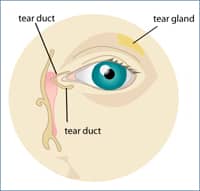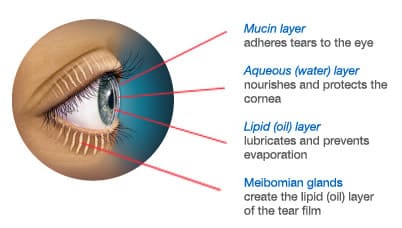Dry Eye Syndrome is one of the most common reasons people seek treatment at Spector Eye Care. When people think about dry eyes, they mainly consider common symptoms, such as dryness, grittiness or burning. However, it is critical to have a sufficient quantity of healthy tears on the surface of the eye to maintain normal vision. Dry Eyes can have significant impact on daily activities, including reading, driving, working and watching television.

Dry eye is extremely common. It is estimated that in the United States alone, 20-30 million people have mild symptoms of dry eye, and another 6 million women and 3 million men have moderate or severe symptoms of dry eye.
Understanding Tears and the Tear Film
The normal tear film is made up of three individual layers. The innermost layer is called the mucous layer, which directly coats the eye and helps the tear film “stick” to the eye. The mucous layer is produced by Goblet cells in the conjunctiva. The middle layer, called the aqueous layer, is composed primarily of saline and electrolytes, and it brings moisture and oxygen to the cornea.

The Lacrimal Gland produces the aqueous layer, which is located under the outer portion of your upper eyelid. The outermost layer of the tear film is called the lipid layer, and it is responsible for preventing the tear film from evaporating. The tiny tubular glands in your eyelids produce the lipid layer. All three layers are critical in maintaining a normal tear film. If any of the three layers of the tear film are deficient you may suffer the symptoms of dry eyes.
Dry Eye is a deficiency of the tear film due to an inadequate production of one’s own natural tears or an excessive evaporation of tears. Whether you suffer from inadequate production of tears or excessive evaporation of tears, or both, you may experience a decrease in the quantity and quality of your tear film, resulting in the surface of the eye being affected.
Inadequate Tear Production
There are many potential reasons that you may not produce an adequate quantity of tears. Several systemic conditions, such as Sjogren’s Syndrome, or autoimmune connective tissue diseases, such as Rheumatoid Arthritis and Lupus Erythematosus, may decrease the quantity of tears that you produce. Patients with Sjogren’s Syndrome may experience dry eyes as well as a dry mouth and arthritis.
Inflammation of the Lacrimal Gland will also cause patients to produce too few tears to maintain a normal and healthy tear film. Other factors include long term contact lens wear, past eye infections, certain allergies and even vitamin deficiencies.
Excessive Evaporation of Tears
There are several factors that can cause an excessive evaporation of tears. These can include environmental factors, such as being exposed to forced hot air heat at home or at work, dry climates in general, air travel, reduced blinking from contact lens wear, reduced blinking from looking at a computer screen or reading for long periods of time, air pollution or even blowing your hair dry.
Your tears may evaporate too quickly if you suffer from low-grade eyelid inflammation, called Blepharitis. Within your eyelids are tiny tubular glands called Meibomian Glands. Any inflammation of the eyelids, such as from Blepharitis, or a condition called Ocular Rosacea, can cause the Meibomian Glands to stop secreting their oily film. This oily film is required as an outer layer of the tear film to prevent evaporation. Without the oily layer being present, it is very likely that you will experience a rapid evaporation of tears and symptoms of Dry Eyes.
This is an especially common problem for perimenopausal women, as it is believed that 75% of women in this age group have some presence of facial rosacea. This, along with the general hormonal changes occurring during this time, make perimenopausal woman particularly susceptible to dry eyes.
Finally, your tear film may evaporate too quickly if the tears are not properly spread and replenished over the surface of the eye due to poor eyelid movement. Poor eyelid movement can result from improper or incomplete closure of your eyes during sleep, eye “bulging” conditions that may be related to thyroid problems, and loss of tone or shape of the eyelids so that they turn in or turn out, called entropion and ectropion.
Diagnosis
Treatment of Dry Eyes
Treatment of dry eyes is complex and requires patience and persistence on the part of the eye doctor and the patient. Depending on the severity and the cause of your dry eyes, we may recommend a number of different treatment options. For mild and moderate dry eyes, unpreserved artificial tears and small environmental or dietary adjustments may be recommended. If these treatments are not enough, punctal plugs may be inserted into the Lacrimal Puncta in your eyelid. In severe cases, Restasis may be prescribed in addition to these other treatments.
Even with the above treatment options, there are some patients that may need further intervention due to an underlying low-grade inflammatory or infectious process. In these cases, it may be necessary for us to also prescribe an oral antibiotic such as doxycycline or an anti-inflammatory eye drop such as a steroid eye drop. With careful diagnosis and a systematic therapeutic approach, sufferers of dry eye syndrome can most often experience considerable improvement.
Follow this link to learn more about the treatment options for Dry Eye Syndrome.